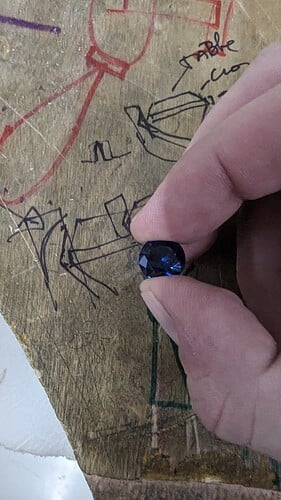Lab grown diamonds are about 2/3 the cost of natural… they are produced from a small diamond seed and purified graphite and compressed to 2 million pounds psi or more (45 to 60 giagpascals), and a temperature as high as 2,000 degrees F (1000 degrees C) to simulate the conditions of natural stone growth at condtions in the earth’s mantle at 150 to 200 km depth where diamonds are naturally formed… These extreme PT conditions have to be contained for a year or more to grow a gem diamond. The process is very energy intensive and also very dangerous because mechanical failure will result in a powerful explosion…but will produce indistnquishable from natural high quality stones… the Chinese are know for selling fraudlent lab diamonds as natural stones… only mine to retail certified stones can be fully trusted, for very high dollar stones…those are deBeers and Australian.
Corundum synthetics were first produced at the turn of the century using an oxyhydrogen flame to slowly accrete powedered alumina with coloring agents (chromium for ruby) This process is very cheap but the end product at best is microcrystalline and if grown too fast, a glass…the internal crystal structure is distorted and unsuited for high quality synthetic stones… it is still used for cheap simulants and for watch bearings. That is called the verneuille process, but Czocharlski technique is a refinement thereof, wherein by the raw materials are heated and very slowly pulled thru a submelting zone to cause crystalization… The process is still the only way to make ultra purity crystalline silicon which later can be doped with trace elements to make semiconductors. i’s a zone refining process…, .
Chatham stones are applicable to both corundum and beryl stones… they are made by a flux fusion method. Lithium molybedate or other chemical materials are used as a flux to lower wthe temperature of melting or aluminum oxide or beryllium oxide… otherwise, the melting temperature of alumina is too high (2000 degrees C, or almost 3,800 F) These stones are more expensive as large crystals take time to grow. What I understand is they can be distinquished from natural crystals by characteristic flux inclusions. Most of the high quality synthetic stones are made by this process…
The hydrothermal method is the only way that synthetic quartz is made… seed crystals can be hung in a high pressure autoclave, with silica and an alkali, such as sodium carbonate (washing soda) with the alkali facilitatiing the dissolution of silica… the solution becomes silica saturated, and the temperature is slowly reduced induce crystallization on the seeds… the pressure is 130 to 145 megapascal (14,500 psi for 100 megapascals)…the temperature has to be at but not exceeding 575 degrees C, low temperature “normal” quartz is the alpha phase, the higher temperature phases are beta quartz, cristobalite and tridymite…a higher temperature than the critical will cause a phase shift and induce twinning and not create a perfect crystal. Synthetic quartz is manufactured on a massive scale for electronics and other applications that exploit it’s piezoelectric properties… think of quartz watches…
Hydrothermal emeralds use a similar method but the crystal shape is not hexagonal… growth lines are distinctive…
Hydrothermal processes best mimic the growth of lower temperature, lower pressure gemstones, particularly those that form in hydrothermal veins and pegmatities… mineral paragenesis in these kinds of deposits fascinate me, as they are also ore forming as well as gemstone forming processes…
Pegmatites host beryl, tourmaline, rose quartz, smokey quartz, amazonite…they are highly enriched in incompatible trace elements that can’t fit into the crystal structure of granite minierals (potassium alkali feldspar, quartz, muscovite mica)…these trace elements crystalize out as gem minerals of unusual composition with lithium, beryllium, cesium, as long as the pressure of crystalization is less than 1 kim depth equivalent (330 kilobars or 33 gigapascal)…pegmatites are abundant where I live in the Black Hills of South Dakota, there are no gem quality beryls, tourmalines, spodumene, emeralds because the depth of crystalisation was 5 km, causing masses of crystal intergrowth…gem crystals can be of gigantic size but it took nature thousands of years to slowly cool superheated hydrothermal solutions to produce them…
Cubic zircornia is produced by the “skull melt” process, first mass produced by the Russians. very refractory material that normally would take 4000 degrees F (for zircornia, it’s almost 5,000 degrees) or higher to melt are placed in a “skull” of the same composition… heating is accomplished in the center by focusing radiofrequency energy on the interior. It’s also called a “cold crucible” process… crystalline cubic zircornia. Cubic zirconia has an isometric crystal structure, of which the cube is a subset… natural zircons have the same chemical composition but are tetragonal in crystal structure. They can be easily distinguished by plane polarized light…the degrees of rotation to extinguish refraction can be done optically…
I hope some fact checks me on what I just wrote and I don’t want to be too didactic…i’ts the geochemist in me that is coming out again… Roy John only knows too much of that… I went on a tangent in a discussion of cracking in a heated sapphrire…
